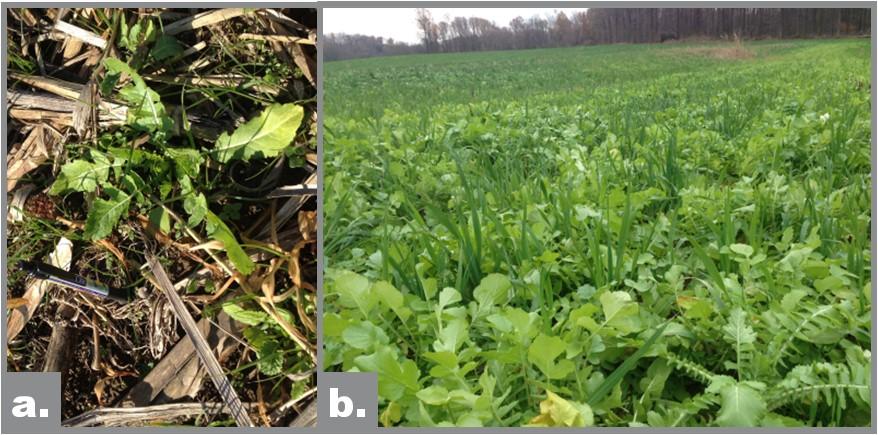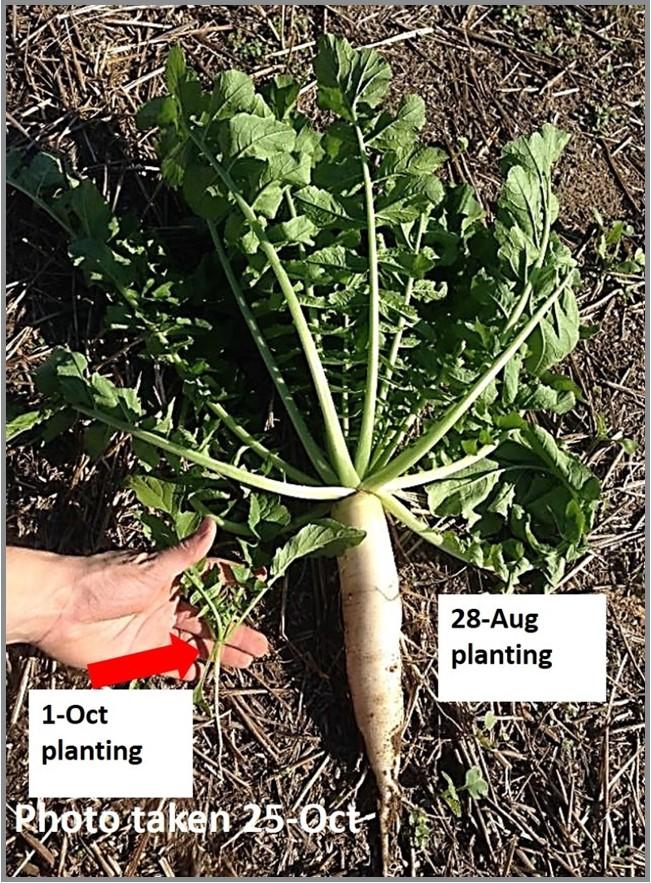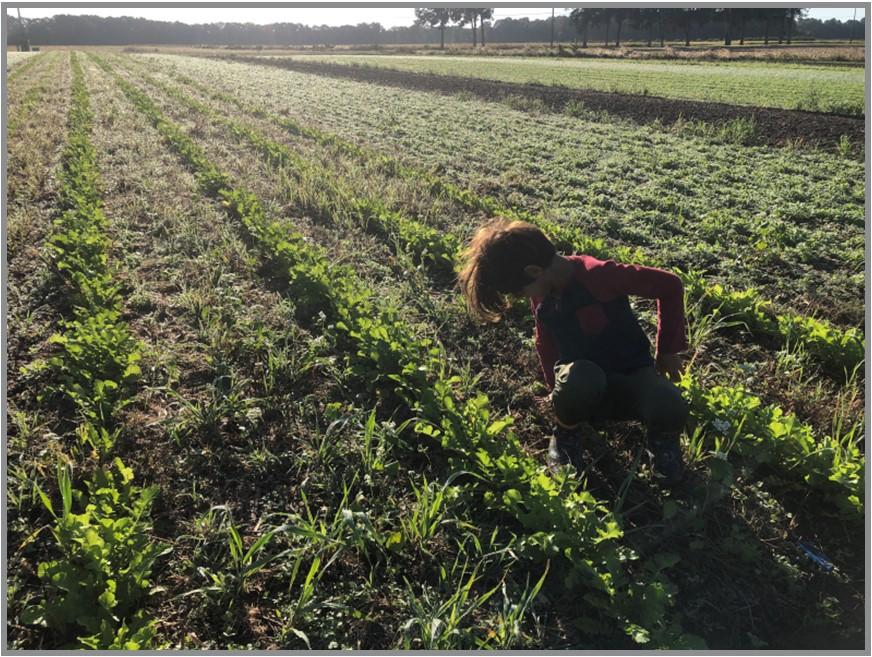
FS-2023-0692 | April 2024
Introduction to Growing Cover Crops in the Mid-Atlantic

Cover crops are crops planted for a primary purpose other than harvest. They are often grown during the time when the primary or harvested crop (cash crop) is not growing, which is sometimes referred to as the “off-season.” In mid-Atlantic grain rotations, cover crops are often planted in the fall and terminated in the spring. However, cover crops can also be grown in other timing windows during the year. For example, in vegetable systems, cover crops may fit in a mid-summer window between colder season cash crops.
Cover crops have many potential benefits to the land and the environment. Most broadly, cover crops are able to take advantage of natural resources that would otherwise be lost from the system, such as sunlight, water and soil nutrients. Many cash crops have a relatively short active growing window (e.g., corn is about three months) and cover crops can potentially take advantage of the natural resources available during the rest of the year. During the off-season, the sun is still shining and cover crops could be capturing energy and carbon through photosynthesis. Rather than running off or leaching through the soil, winter rains could be utilized by cover crops. Microbes are still active during much of the year, and therefore, nutrients released through microbial processes could be taken up by cover crops. Cover crop roots can also have symbiotic relationships with microbes such as nitrogen fixing bacteria and mycorrhizal fungi, which can support microbial populations and improve soil health. Since cover crops are not grown for harvest, their decomposing biomass can add the captured carbon and nutrients back to the soil.
Cover cropping also serves as a way to practice crop rotation. Crop rotation is a foundational principle of sustainable agriculture, and a way to potentially help conserve soil, maintain balanced fertility, control pests, and achieve other agronomic benefits. In modern agriculture systems, there are often limited opportunities for crop rotation due to market constraints, labor constraints, equipment limitations, etc. Incorporating diverse cover crops into the rotation can provide similar benefits to rotating cash crops, even when a limited variety of cash crops are grown.
Cover crops are often grown with a specific goal in mind. Some potential benefits of a cover crop include:
- Preventing soil erosion
- Scavenging nutrients and preventing leaching
- Building soil organic matter
- Alleviating soil compaction
- Encouraging beneficial insects or pollinators
- Adding nitrogen to the system
- Controlling pests such as weeds
However, in supporting these benefits, all cover crops are not equal. For example, figure 1 shows two cover crops providing different levels of benefits to the land and subsequent cash crops. While these two cover crops have comparable species, the cover crop in photo (a) was planted one month later than the cover crop in photo (b), leading to drastically different outcomes. By mid-November, the cover crop in photo (a) took up 3 pounds of nitrogen per acre, while the cover crop in photo (b) took up 45 pounds of nitrogen per acre (Hirsh et al., 2021). This highlights the importance of being intentional about cover crop management. The management of the cover crop will largely determine what benefits it will offer. Key factors to consider include cover crop species and mix selection, planting date and method, seeding rate, and termination date and method.
Ultimately, the “best” cover crop to plant in any situation will depend on the goals to be achieved, the “cover cropping windows” in the cash crop rotation (i.e., when is the land available for cover crops), and many management and equipment factors.
Cover crop species
Cover crops are often categorized into three functional groups: grasses, brassicas, and legumes. Popular grasses include wheat, rye, triticale, oat, and barley. Popular brassicas include forage radish, rapeseed, mustard, and turnip. Popular legumes include clovers (crimson, red, white), Austrian winter pea, and vetch. However, cover crops are not necessarily limited to a narrow list of species; many plant species can be used as cover crops if they are planted for a primary purpose other than harvest. As a rule of thumb, a mixed species cover crop that includes multiple functional groups (e.g., grass, brassica, legume) provides advantages compared to a monoculture cover crop. However, there are exceptions, especially if a very specific purpose is being targeted. For example, a monoculture cereal rye cover crop that is terminated late in spring and rolled down is likely to be the best option for producing a thick, weed-suppressing mulch ahead of a no-till soybean crop in a field infested with small-seeded annual weeds like pigweed.
Cover crop timing

Just as important as cover crop species is the growth window of when that species is in the field. The same cover crop species can accumulate dramatically different amounts of biomass and fulfill very different functions, depending on when it is planted and terminated. For example, the two forage radish cover crops in Figure 2 were planted in side-by-side plots, one month apart. Cover crop planting and termination timing is key in determining which species are appropriate. For example, winter-killed species such as forage radish are typically not worth planting after mid-September in much of the mid-Atlantic region. Cereal rye is a grass that can still perform well with late fall plantings. If the goal is nitrogen fixation, fall-seeded legumes should have a long enough growing period in the spring to accumulate biomass.
Cover crop termination
Before planting cover crops, it is important to have a plan for cover crop termination. Cover crops should not be grown that cannot be effectively terminated, as they can become a weed in subsequent crops. Factors to consider regarding cover crop termination include the type of operation, the scale or acreage of the cover crop, and available equipment to terminate cover crops. Chemically terminating cover crops (using herbicide) will allow the most flexibility in timing. For most cover crop species, a broad spectrum herbicide will kill the cover crops at a variety of growth stages, and the cover crop material can be left on the soil surface as a mulch.
Mechanical termination methods can also be used, such as tillage, or mowing in addition to tillage. Multiple tillage passes may be required, especially for cover crops with extensive root systems. Incorporating the cover crop in the soil through tillage will allow the cover crop to decompose and release nutrients more quickly. However, the cover crop benefit of mulching the soil surface will be lost. Some cover crops can be terminated with a roller crimper, which knocks down the cover crop and uses mechanical action to break the vascular system and kill the plant. Both species selection and timing is important to successfully kill the cover crop with a roller crimper. The likelihood of a complete kill by rolling increases the longer the cover is allowed to mature into the reproductive and seed-formation stages, but waiting too long can result in production of viable seed and a future weed problem. Some cover crops, such as forage radish or spring oat, when planted in the fall will “winter-kill,” or die naturally during the coldest winter months. While these species typically winter-kill in cooler parts of the mid-Atlantic, a back-up plan for termination should be in place in case of a mild winter. For smaller-scale operations, cover crops can be terminated by tarping the cover crop for 3-4 weeks, preventing sunlight from reaching the plants.
Effect of cover crops on subsequent crops
Cover crops can potentially influence the soil and farming system following their termination as well as while they are growing. If cover crops are left on the soil surface after termination, they will provide a surface mulch. This mulch will suppress weeds, keep the soil surface cooler, impede evaporation, and conserve moisture in the soil. The carbon to nitrogen (C/N) ratio of cover crop residue will determine how quickly it decomposes and whether it will release or immobilize (tie up) nutrients during decomposition. Both species selection and growth stage at termination influence the C/N ratio. Higher C/N ratios result in slower plant-available nitrogen, and lower C/N ratios result in quicker plant-available nitrogen. For example, cereal rye at anthesis (stage when pollen is shedding) has a C/N ratio of approximately 37/1, mature hairy vetch has a C/N ratio of approximately 11/1, and a 50/50 mix of cereal rye at anthesis and hairy vetch has a C/N ratio of approximately 24/1. Only when the C/N ratio drops below approximately 24/1 is the nitrogen in the above-ground biomass expected to be available in the first year for a subsequent crop to utilize, which may or may not be desirable depending on the following cash crop being grown. The cover crop biomass or residue can affect the planting of the subsequent cash crop. For example, depending on the available planting equipment, a thick cover crop mulch may be difficult to seed into. Late-terminated cover crops may harbor pests such as slugs that feed on the subsequent crop; however, on the other hand, a late-terminated cover crop may be beneficial if the slugs feed on that cover crop rather than the cash crop. Furthermore, late-terminated cover crop biomass may also harbor beneficial insects.
Get creative

Creative strategies can enhance the benefits of cover crops. For example, a winter-killed brassica, such as forage radish, can be planted in 30-inch rows with an annual grass broadcast in between the rows (Figure 3). By spring, the radish will have winterkilled, leaving very fertile strips with loose uncompacted soil into which corn can be planted. Meanwhile, the grass can be chemically terminated to serve as a mulch in between the corn rows. This strategy also avoids the problem of the radish outcompeting other species in the mix.
In summary, cover crops can be grown for a variety of agronomic and environmental purposes. However, the effect of cover crops on subsequent cash crops and the environment will vary depending on how intentionally and effectively they are managed to achieve those purposes. Cover crop species and mixtures, timing and growth window, termination, and the effect of cover crops on subsequent crops should all be considered when planning and implementing cover crop systems.
To learn more, consult these cover crop resources:
- Ackroyd, V., Flessner, M., Pittman, K., Rubione, C., Shergill, L., VanGessel, M., & Mirsky, S. (2024, February 2). Cover crops as a weed management tool. GROW. https://growiwm.org/cover-crops
- Clark, A. (Ed.). (2007). Managing cover crops profitably (3rd ed.). SARE,USDA. https://www.sare.org/resources/managing-cover-crops-profitably-3rd-edition/
- Hirsh, S. M., Duiker, S. W., Graybill, J., Nichols, K., & Weil, R. R. (2021). Scavenging and recycling deep soil nitrogen using cover crops on mid-Atlantic, USA farms. Agriculture, Ecosystems & Environment, 309, 107274. https://doi.org/10.1016/j.agee.2020.107274
- Maryland Department of Agriculture. (2024, February 2). 2023 small acreage cover crop program. https://mda.maryland.gov/resource_conservation/Pages/Small-Acreage-Cover-Crop-Program.aspx
- Maryland Department of Agriculture. (2024, February 2). Maryland’s 2023-2024 cover crop program. https://mda.maryland.gov/resource_conservation/pages/cover_crop.aspx
- Myers, R., Weber, A., & Tellatin, S. (2019). Cover crop economics: Opportunities to improve your bottom line in row crops. SARE, USDA. https://www.sare.org/resources/cover-crop-economics/
- Northeast Cover Crop Council. (2024, February 2). Sowing sustainability. https://northeastcovercrops.com/
- Virginia NRCS. (2015). Virginia NRCS Cover Crop Planning Manual 1.0 (Virginia Technical Note, Agronomy #10). USDA, NRCS. https://efotg.sc.egov.usda.gov/references/public/va/VA_TN10_Agronomy.pdf
SARAH M. HIRSH
shirsh@umd.edu
This publication, Introduction to Growing Cover Crops in the Mid-Atlantic (FS-2023-0692), is a part of a collection produced by the University of Maryland Extension within the College of Agriculture and Natural Resources.
The information presented has met UME peer-review standards, including internal and external technical review. For help accessing this or any UME publication contact: itaccessibility@umd.edu
For more information on this and other topics, visit the University of Maryland Extension website at extension.umd.edu
University programs, activities, and facilities are available to all without regard to race, color, sex, gender identity or expression, sexual orientation, marital status, age, national origin, political affiliation, physical or mental disability, religion, protected veteran status, genetic information, personal appearance, or any other legally protected class.
When citing this publication, please use the suggested format below:
Hirsh, S.M. (2024). Introduction to Growing Cover Crops in the Mid-
Atlantic (FS-2023-0692). University of Maryland Extension. go.umd.edu/
FS-2023-0692.